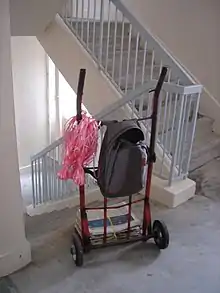Karung guni
The practice of Karang guni is common in Singapore. Its practitioners are a modern form of rag and bone men that visit residences door-to-door.[1] They can either walk along corridors (if that particular HDB estate has a covered carpark) or for certain HDB estates where the carpark is right under the HDB blocks, walk through the carpark downstairs honking a horn. However, around landed properties, they may drive around in a lorry with a horn attached to it, instead of going door-to-door. They make visits in carts, collecting old newspapers and other unwanted items. These will be resold at specialized markets and eventually recycled or reused. "Karang guni" is a Malay phrase for gunny sack, which was used in the past to hold the newspapers. The Karang guni men would haul the heavy sacks on their backs as they walked their rounds to do the collection. Today, most of them use a hand truck instead.

These people can be distinguished by their use of horns or (rarely) hand bell and shouts of "karang guni, poh zhua gu sa kor, pai leh-lio, dian si ki..." ("Rag and bone, newspapers and old clothes, spoilt radios, televisions" in Singlish and Hokkien) when making their rounds.[2] Depending on the person, a nominal fee is paid for the quantity of newspapers or unwanted items sold.
The karang guni industry is made highly profitable due to the dense urban nature of Singapore, where hundreds of public housing Housing Development Board apartment units are located in one block, with often a dozen blocks in each housing estate. This gives the karang guni men large access to sources of scrap.[3] There are reported stories of rag-to-riches, karang guni men who have become millionaires just from the karang guni business.[4] Today, however, competition is usually too great.[5]
Second-hand items in good condition bought by the karang guni men are usually resold in flea markets such as Sungei Road, though in recent times some have begun listing items additionally on online auctions.[6] Because karang guni men are motivated by the resale value of these materials on the market, there are also reported cases where some collectors have been selective in what to receive from households, even though they may be still recyclable or reusable.[7][8]
At the beginning of the 21st century, karung guni men are facing competition from government recycling initiatives and charities that directly collect from residents material to be recycled.[9][10] A few karang guni men have been prosecuted for attempting to steal scrap material from the green recycling bags placed outside housing units for collection.
References
- Brown A. Singapore English in a Nutshell: An Alphabetical Description of Its Features. Federal Publications, 1999. page 121.
- Mak Mun San (9 December 2007). "Driven honking mad". The Straits Times.
- Michelle Tan (13 April 2001). "Karang guni man who gets up to $1,000 a day". The Straits Times.
- Joyce Lim (11 August 2007). "He grows fortune from discarded computers". The New Paper.
- "He grows fortune from discarded computers". Singapore Forums by SGClub.com. Retrieved 2015-06-22.
- "Karung guni men hit eBay". The Straits Times. 12 July 2005.
- Hannah Lim (4 May 1999). "Singaporeans are not wasteful, just prudent". The Straits Times Forum.
- Grace Chua (1 December 2008). "Blow to recycling as plastic prices plummet". The Straits Times.
- Josephine James (27 October 2000). "Newspaper wars - Charity project versus karang guni". The Straits Times.
- Josephine James (26 June 2001). "Paper war - Karang guni men versus CDCs". The Straits Times.